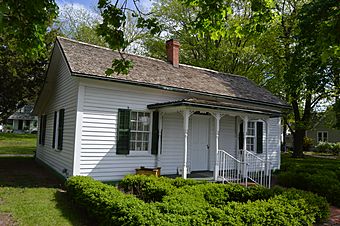Bryant Cottage State Historic Site facts for kids
Quick facts for kids |
|
|
Bryant House
|
|
 |
|
| Location | 146 E. Wilson St, Bement, Illinois |
|---|---|
| Area | less than one acre |
| Built | 1856 |
| Architectural style | vernacular, hall-and-parlor |
| NRHP reference No. | 100001566 |
| Added to NRHP | September 5, 2017 |
The Bryant Cottage State Historic Site is a simple four-room house in Bement, Illinois. It was built in 1856. Today, the Illinois Department of Natural Resources keeps it safe. It shows what pioneer homes in Piatt County, Illinois looked like. It is also a very important place linked to the famous 1858 Lincoln-Douglas debates.
Contents
Who Was Francis E. Bryant?
Not many people lived in southern Piatt County, Illinois, until the 1850s. This was when the railroad finally arrived. The land was flat and open, and there were not many trees for firewood in winter.
Francis E. Bryant came to Bement in 1856. He had some money and quickly used it to start businesses. He was a banker and a store owner. He bought grain from farmers and sold them lumber and coal.
Bryant was a member of the Democratic Party. He was also a friend of Senator Stephen A. Douglas. Douglas was running for re-election in 1858. Bryant helped gather support for Douglas during the election.
Bryant was elected to the Illinois Legislature twice. First, he represented Schuyler County, Illinois in 1853. Then, 20 years later in 1873, he represented Champaign County, Illinois and Piatt County, Illinois.
Stephen A. Douglas and the Debates
In 1858, Stephen A. Douglas was a U.S. Senator from Illinois. Back then, state lawmakers chose senators, not the voters directly. So, Douglas did not expect to campaign much.
However, there was a big disagreement about American slavery in the country. This made the 1858 election very special. People from both the Democratic Party and the new Republican Party wanted the candidates to talk directly to the public.
The Republicans chose Abraham Lincoln, a lawyer from Springfield, Illinois. On July 24, 1858, Lincoln wrote to Douglas. He challenged Douglas to have nine debates across Illinois. They met in person on July 29 on the Bement-Monticello road, which is now Illinois Route 105. Lincoln repeated his challenge then.
Douglas was traveling south to Bement at that time. He planned to stay the night at the Bryant Cottage. It was during this one-night stay that Douglas decided to accept most of Lincoln's challenge. He agreed to debate Lincoln seven times.
On the morning of July 30, Douglas wrote to Lincoln from Bement. He suggested they debate in Ottawa, Freeport, Jonesboro, Charleston, Galesburg, Quincy, and Alton, Illinois. Lincoln agreed to these terms in a letter dated July 31.
Abraham Lincoln's Role
In July 1858, Stephen A. Douglas was an experienced U.S. Senator. Abraham Lincoln, however, was a lawyer with little experience holding public office. Illinois Republicans chose him to run against Douglas because he was a good speaker. He could talk about slavery in a way that showed he was against it, without upsetting too many voters.
Douglas could have avoided Lincoln's challenge to debate. As the current senator, he was already well-known. But Douglas chose to debate because he agreed that slavery was a growing problem. He also believed his idea of "popular sovereignty" could solve it. This idea meant that people in new territories should decide for themselves if they wanted slavery.
At first, Douglas seemed to win this challenge. His party's candidates won the state elections in November 1858. This meant Douglas was re-elected as senator. However, Lincoln and Douglas faced each other again over slavery in the 1860 presidential election of 1860. In that final contest, Lincoln won and became president.
Stories About the Cottage
After both Douglas and Lincoln had passed away, the Bryant family believed a story. They thought that Douglas and Lincoln had met in the parlor of the Bryant Cottage. They thought the two men had worked out the details of their debates there.
We know that Douglas decided to accept Lincoln's challenge while staying at the Bryant Cottage. But the letters between them suggest they worked out the debate details on paper. This happened after their face-to-face meeting on the road on July 29, 1858. A writer named Jim Fay looked into this story in 1998. He found some clues that a meeting in the parlor might have happened. But the mystery around it shows how clever and private the candidates were.
The Cottage Today
Because of state budget cuts, the Bryant Cottage State Historic Site was closed for a short time. It was closed from October 2008 until April 2009. The site reopened to visitors on April 23, 2009.
In September 2017, the Bryant Cottage State Historic Site was added to the National Register of Historic Places. It was recognized for its unique "folk hall-and-parlor" style of architecture. It was also honored for its important connection to the 1858 Lincoln-Douglas Debates.



